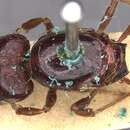en
names in breadcrumbs


Taxonomy. The genus Pheidologeton is assigned to the Carebara genus group of the tribe Solenopsidini (Bolton 2003). The genus was preliminarily reviewed by Yamane (2000). Workers of Vietnamese species have the following features.
Worker polymorphic; head in full-face view oval or subrectangular in minor, subrectangular or subtrapezoidal with roundly expanded vertexal lobe in media and major; frontal carina and antennal scrobe absent; median portion of clypeus not margined laterally by conspicuous carinae; posteromedian portion of clypeus relatively broadly inserted between frontal lobes; median clypeal seta absent; mandible triangular, 4-6 teeth on masticatory margin (teeth more rounded or worn in major); antenna 11-segmented, with 2-segmented club; eye small to moderate in size, sometimes consisting of only a few ommatidia; mesosoma in lateral view relatively slender in minor, but short and robust in major; promesonotum in lateral view usually well raised as a dome, much higher than anterodorsal border of propodeum; promesonotal suture completely absent dorsally in minor, but often conspicuous in major; posterior slope of promesonotal dome often with a prominence in major; metanotal suture weakly impressed dorsally; propodeal spine always present, but variable in size and shape; propodeum lobe low or almost absent; petiole consisting of anterior peduncle and node (but anterior peduncle ill defined from node in major); gastral shoulder distinct to indistinct.
The minor worker of Pheidologeton is similar to the minor of Oligomyrmex (for distinguished characters see under Oligomyrmex ) and the worker of Lophomyrmex (see under Lophomyrmex ).
Vietnamese species. One species has been described from Vietnam: varius Santschi (type locality: Ho Chi Minh City). Four additional species have been recognized by us from Vietnam: diversus (Jerdon) [= sp. eg-3] (Nam Cat Tien, Ninh Thuan, Pu Mat, Quang Tri, Tam Dao); trechideros Zhou et Zheng [= sp. eg-1] (Chua Yen Tu, Pu Mat, Tay Yen Tu, Van Ban); vespillo Wheeler [= sp. eg-2] (Ba Vi, Cuc Phuong, Tay Yen Tu); sp. eg-4 [= cf. affinis (Jerdon)] (Binh Chau-Phuoc Buu, Cuc Phuong, Nam Cat Tien, Pu Mat).
Bionomics. Pheidologeton diversus usually inhabits urban areas, bare lands, grasslands, forest edges and sparse forests. In contrast, the other Vietnamese species of Pheidologeton inhabit rather developed forests. Pheidologeton conlonies are extremely large and usually occur in soil under logs and stones. Permanent foraging trails, galleries and tunnels extend outward from the nests. A mass of foragers gather various kinds of food such as living and dead invertebrates, honeydew of homopterans and plant matter (nectar, fruits, seeds, etc).
Carebara is a genus of ants in the subfamily Myrmicinae. It is one of the largest myrmicine genera with more than 200 species distributed worldwide in the tropics and the Afrotropical region. Many of them are very tiny cryptic soil and leaf-litter inhabitants. They nest in rotten wood to which the bark is still adherent in the Afrotropical region, or may be lestobiotic nesting near other ant species. Some species are known to exist parasitically within termite nests. Little is known about the biology of the genus, but they are notable for the vast difference in size between queens and workers.[3][4]
Carebara is a genus of ants in the subfamily Myrmicinae. It is one of the largest myrmicine genera with more than 200 species distributed worldwide in the tropics and the Afrotropical region. Many of them are very tiny cryptic soil and leaf-litter inhabitants. They nest in rotten wood to which the bark is still adherent in the Afrotropical region, or may be lestobiotic nesting near other ant species. Some species are known to exist parasitically within termite nests. Little is known about the biology of the genus, but they are notable for the vast difference in size between queens and workers.
Pheidologeton est un genre de fourmis, aussi appelées fourmis maraudeuses du fait de leurs raids semblables à ceux menés par les fourmis légionnaires.
Les nids de Pheidologeton sont plus permanents que ceux des fourmis légionnaires, mais presque aussi grands. Le genre Pheidologeton se distingue également par son important polymorphisme: au sein des fourmis travailleuses, les différences de taille sont importantes.
Il y a environ 42 espèces ou sous-espèces de ce genre. Géographiquement, le genre Pheidologeton s'étend de l'Afrique jusqu'à l'Australie, en passant par l'Asie du Sud.
Deux espèces fossiles sont connues.
Pheidologeton é um gênero de insetos, pertencente a família Formicidae.[1]
Pheidologeton é um gênero de insetos, pertencente a família Formicidae.
Pheidologeton (лат.) — род средних и мелких по размеру муравьёв трибы Solenopsidini из подсемейства Myrmicinae, семейства Formicidae. Более 30 видов.
Тропики Старого Света: Африка, Азия (от Индии до Новой Гвинеи), Австралия.
Рабочие муравьи имеют длину от 2 до 16 мм. Каста рабочих сильно полиморфная. Усики 11-члениковые с апикальной 2-члениковой булавой. Мандибулы с 5—6 зубцами. Глаза сравнительно мелкие. Имеют 2 нижнегубных и 2 нижнечелюстных щупиков (формула 2:2). Спина грудки (промезонотум) выпуклая; метанотальная бороздка явная; проподеум с шипиками. Внешняя морфология крупных солдат сходна с таковой у маток — есть оцеллии, промезонотальный шов, аксиллы, строение метанотума. Жевательный край мандибул почти без зубчиков у крупных рабочих и солдат.
Род относится к трибе Solenopsidini (Myrmicinae) и к нему относят более 30 видов[1].
Pheidologeton (лат.) — род средних и мелких по размеру муравьёв трибы Solenopsidini из подсемейства Myrmicinae, семейства Formicidae. Более 30 видов.